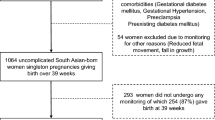Abstract
Purpose
To test the reliability of the admission test to identify the compromised fetus and thus reduce the neonatal morbidity and mortality by early intervention.
Methods
A prospective analysis over a period of 1 year from December 2007 to December 2008 included 100 antepartum patients and were evaluated for perinatal outcome in two groups.
Results
In both low and high risk groups the incidence of meconium staining was 25 and 37.5% in patients with nonreactive traces as compared to 8.6 and 9.5%, respectively, in reactive traces with specificity of 90.9%. Clinically detected fetal distress was more common in patients with nonreactive test. Operative interference for fetal distress was more in patients with nonreactive test. Occurence of low Apgar score was more in patients with nonreactive test. Admission to neonatal unit was more in nonreactive than reactive traces. Incidence of neonatal death was more in nonreactive test. Incidence of low birth weight was more in nonreactive trace group and more so in high risk group than in low risk group.
Conclusion
Admission test may be best recommended in all patients irrespective whether they are in low or high risk as incidence of neonatal morbidity is high 33.3% babies required NICU admission and 33% babies expired in nonreactive tracing, in centers where advance facilities are not available. Whenever there is a nonreactive tracing further test should be carried out.



Similar content being viewed by others
References
Gabbe SG, Simpson S (2002) Intrapartum Fetal Evaluation, Obstetrics; Normal and Problem Pregnancies. Churchill Livingstone
Paul WM, Ouillingan EJ, Maclachlan T (1964) Cardiovascular phenomena associated with fetal head compression. Am J Obstet Gynecol 90:824
American College of Obstetricians and Gynecologists technical bulletin (1995) Fetal heart rate patterns: monitoring, interpretation and management No. 207 July 1995. Int J Gynaecol Obstet 51(1):65–74
FIGO Guidelines for the use of fetal monitoring. Int J Obstet Gynecol 1987; 25:159-167
Ingemarsson I, Arulkumaran S, Ingemarsson E, Tambyraja RL, Ratnam SS (1986) Admission Test: a screeninng test for fetal distress in labor. Obstet Gynecol 68:800
Sarno AP Jr, Ahn MO, Brar HS, Phelan JP, Platt LD (1989) Intrapartum Doppler velocimetry, amniotic fluid volume and fetal heart rate as predictors of subsequent fetal distress. I. An initial report. Am Obstet Gynecol 161(6 Pt 1):1508–1514
Sood AK (2002) Military Hospital Jodhpur, J Obstet Gynecol India 52(2):71-75
Mires G, Williams F, Howie P (2001) RCT of CTG versus Doppler auscultation of fetal heart rate at admission in labor in low risk obstetric population. BMJ 322:1457–1462
Chua S, Arulkumaran S, Kurup A, Anandakum C, Selemat N, Ratnam SS (1996) Search for the most predictive tests of fetal well being in early labor. J Perinatol Med 24
Kulkarni AA, Shrotri AN (1998) Admission test: a predictive test for fetal distress in high risk labor. J Obstet Gynaecol Res 24:255
Schifrin BS, Lapidus M, Doctor GS, Leviton A (1975) Contraction stress test for antepartum fetal evaluation. Obstet and Gynecol 45:433
Serafini P, Lindsay MBJ, Nagey DA, Pupkin MJ, Tseng P, Crenshaw C (1984) Antepartum fetal heart rate response to sound stimulation: The acoustic stimulation test. Am J Obstet Gynecol 148:41–45
Conflict of interest statement
None.
Author information
Authors and Affiliations
Corresponding author
Rights and permissions
About this article
Cite this article
Khandelwal, S., Dhanaraj, M. & Khandelwal, A. Admission test as precursor of perinatal outcome: a prospective study. Arch Gynecol Obstet 282, 377–382 (2010). https://doi.org/10.1007/s00404-010-1406-4
Received:
Accepted:
Published:
Issue Date:
DOI: https://doi.org/10.1007/s00404-010-1406-4




